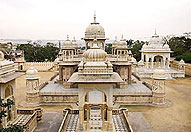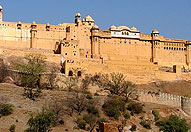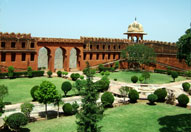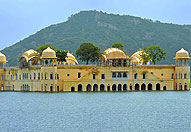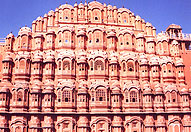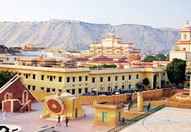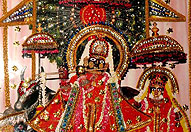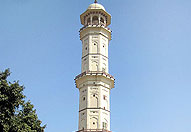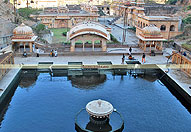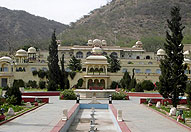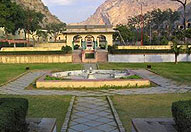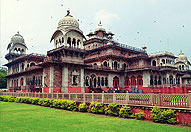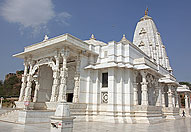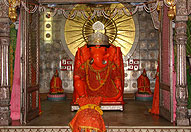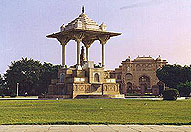Amber Fort Jaipur:
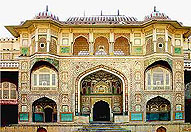
Amber: The Kachhawahas ruled from Amber, 11 km from Jaipur, for seven centuries.
With a history so old, it is not unexpected that there is a lot of the past that
can be traced in its archaeological history. While many of the very early structures
have either disappeared or been ruined, those dating from the 16th century on are
in a remarkable state of preservation. Amber as it exists now is the handiwork of
three of the kingdom's rulers that include Man Singh and Jai Singh I and II. Approached
from a steep ramp, visitors ride up on elephant back, entering through the grand
Singh Pol gateway and continuing to JalebChowk, the courtyard where they disembark
from the pachyderm. From here, they are faced with two flight of steps, one leading
to the Shila Mata complex with its enshrined image of the goddess, and the other
to the main palace complex. Within the complex, Ganesh Pol, an imposing gateway
painted with images of the elephant-headed God, Lord Ganesha, takes pride of place.
Also a part of the complex is the Diwan-I-Am or hall of public audience with its
spectacular display of pillars. The typical merging of Rajput and Mughal architectural
styles is captured in the SukhNiwas and Jas Mandir Apartments, and the Charbagh
garden with its perfectly proportioned landscaping. A highlight is the pierced screen
windows which offer views from points of vantage, as well as the shimmering mirrors
encrusting the wall of the Sheesh Mahal. Several other gardens and pavilions within
the sprawling spread of the ramparts offer enough scope for investigating medieval
lifestyles at leisure. Beyond the ramparts, the old city, once the abode of the
aristocracy, has a wonderfully medieval flavour, though it has few buildings of
majestic proportion that are still extinct. However, a walk though the rambling
lanes will reap rich reward for the curious. Besides a large number of temples,
there are also stepwells, memorials and townhouses.
Gaitore Jaipur:
GaitoreLocated off the Jaipur-Amber road, Gaitors is the final resting place for
the maharajas of Jaipur. Set in a narrow valley, the cenotaphs of the former rulers
consist of the somewhat typical chhatri or umbrella-shaped memorials. Of special
mention is Jai Singh 2nd chhatri because of the carvings that have been used to
embellish it.
Nahargarh Jaipur:
The third of the hilltop forts that guard Jaipur, and in a state of majestic ruin,
it has some lovely gardens and pavilions added after the capital had shifted to
Jaipur. The members of the royal family often used it for summer excursions and
picnics.
Jaigarh Jaipur:
One of the few military structures of medieval India, retaining its ancient splendour
in palaces, garden, reservoirs, a granary, an armoury, a well planned cannon foundry,
several temples, a tall tower and a giant mounted cannon the Jai Ban, one of the
largest in the country are preserved here. The extensive parkotas (walls), watch
tower and gateways of Jaigarh dominate the western skyline.
Jal-Mahal Jaipur:
JalMahal was built by Sawai Pratap Singh in 1799 AD in the midst of the Man Sagar
Lake as a pleasure spot. The was formed by constructing dam between the two hills
by Sawai Man Singh I. During winter months once can see a large number of migratory
as well as residents birds at the lake.
Hawa Mahal Jaipur:
Located to one side, but a part of the City Palace complex, HawaMahal is best viewed
from the street outside. If is were not for the bustling bazaar all around, it would
have been easy to mistake it for a film set, so exquisitely is it proportioned,
and so incongruous is its delicacy. HawaMahal consists of five tiers of corridors
on the inside, with pierced screen windows that overlook the street below. It is
believed the women of the royal zenana would sit concealed behind these screens
to see life in the city beyond the walls of the palace.
City Palace Jaipur:
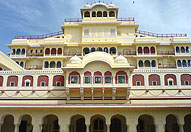
As may be expected, the City Palace complex lies at the heart of the city. Getting
in is simpler than it once was. Though the erstwhile maharaja and his family and
close friends use the triple-arched Tripolia Gate to enter their section of the
palace, most visitors are ushered in through Atish Pol which is located close to
the royal stables, cross from here to ChandniChowk or Moonlit Square and then on
to GaindakiDeorhi. At the heart of the complex is seven-tiered Chandra Mahal where
the erstwhile royal family is still in residence, though only a small part of the
apartments are occupied. However, it is only the buildings around Chandra Mahal
that are open to the public, and these also form part of a museum which includes
everything from Grand outfits (including one with 18 kilos of golden thread woven
into it) to swords and two silver urns that are believed to be the largest silver
objects in the world. These are housed in the Mubarak Mahal, and the Diwan-i-am
respectively. Through Singh Pol, visitors can approach the Diwan-i-am, where the
maharaja's private and public courts would be held. The architecture seems to consist
of a number of arched, pillared halls, while courtyards with painted doorways are
prominent feature.
Jantar Mantar Jaipur:
A stone observatory, part of the city palace complex, JantarMantar is one of several
other astronomical observatories created by Maharaja Sawai Jai Singh 2nd (other
are in Delhi, Banaras, Ujjain). These concrete masonry instruments were used to
measure everything from altitude to time, and map the movement of the planets and
the stars. Jai Singh 2nd had a passion for astronomy and used astronomical inventions
from different of these observatories, the largest of which in is Jaipur.
Govind Dev ji Temple Jaipur:
The most popular spireless temple of Jaipur dedicated to Lord Krishna. It is located
in the central pavilion of the Jai Niwas Garden to the north of Chandra Mahal. The
image of the patron deity GovindDevji, originally installed in a temple of Vrindavan,
was reinstalled here by Sawai Jai Singh 2nd as his family deity.
Sargasuli Jaipur:
ToAlso known as IsarLat, this tower was erected in the mid-18th century by Maharaja
Ishwari Singh to commemorate a battle victory. Ironically, Ishwari Singh was ostracized
for his lover of a common girl, and he is the only Kachhawaha Maharaja who has not
been commemorated at Gaitor.
Galtaji Temple Jaipur:
An ancient pilgrimage centre, lying beyond the gardens amidst low hills. Temples,
pavilions and holy kunds (natural spring and reservoirs) along with lush landscape
make it a delightful spot. The small temple of the sun god, built by DiwanKriparam
on the top of the highest peak is visible from all parts of the city.
Sisodia Rani Ka Bagh Jaipur:
In the 18th and 19th centuries, the royals and the nobles laid out summer gardens
at Ghatikiguni, a valley at beginning of the Jaipur-Agra road which traps the breezes
and wafts it through pleasantly. Sisodia Rani ka Bagh was laid for one of the queens
from the lake city of Udaipur, to cure her of her homesickness. It consists of pavilions
with water channels that run down in tiered gardens.
Vidyadharjika Bagh Jaipur:
The exquisite, tiered garden laid for the private pleasure of the architect of the
city, it has delicate pavilions bordered by water channels, and a larger pavilion
overlooking the whole complex. Located at GhatkiGuni, it is now let out for private
picnics.
Jain TempleChulgiri Jaipur:
One of few example of Jain architecture in Jaipur, located on the Agra Road, it
has 19th century frescos that are exquisite.
Ram Niwas Bagh Jaipur:
A lush spacious garden with a zoo, an aviary, a greenhouse, a herbarium, amuseum
and popular sports ground. It was built by Sawai Ram Singh 2nd in 1868 A.D. as a
famine relief project. The Albert hall, fine example of Indo Sarcenic style of architecture
designed by Sir SwintonJecob, was opened later with an exquisite collection of sculptures,
paintings, decorative wares, natural history specimen, an Egyptian mummy & celebrated
Persian carpet. Recently, the RabindraManch with an auditorium, a modern art gallery
and an open air theatre, has been added to promote cultural events.
Laxmi Narayan Temple Jaipur:
A new temple, built entirely of marble, this is a showcase of the continuing skill
of the mason and the sculptor. Also Known as Birla Temple Jaipur
Moti Doongari Jaipur:
A small palace, this is a replica of a Scottish castle, and perched on a hilltop.
Once occupied by Maharaja Madho Singh's son who was confined here, it was also for
a while home to Maharani Gayatri Devi.
Statue Circle Jaipur :
A busy crossing, this has a life-size statue in marble of Maharaja Jai Singh 2nd.
It is a recent addition to the city's attractions.

